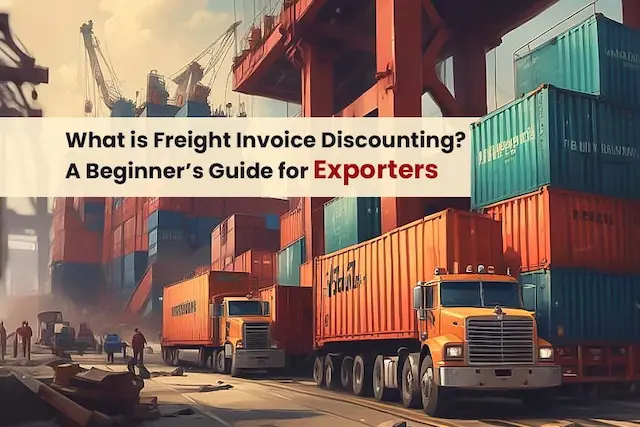Running a business, you’ve probably faced the problem of waiting for customers to pay their invoices. That’s where Invoice Discounting and Invoice Factoring come into play.
With Invoice Discounting, you get a cash advance, but you’re still in charge of getting paid from your customers. It’s like a DIY cash boost. On the other hand, Invoice Factoring gives you more cash upfront, but the factoring company takes over chasing payments. It’s like having a financial partner in your corner.
So, it’s a choice between control (Discounting) and more cash (Factoring). Which one would you choose? Before taking any decision, understand what’s the difference between Invoice Discounting and Invoice Factoring?
What is Invoice Discounting?
Invoice discounting is a financial arrangement used by businesses to improve their cash flow by obtaining funds against their outstanding invoices before the customers actually pay.
It is a form of short-term financing that helps businesses access a portion of the money they are owed by their customers, allowing them to meet immediate financial needs, such as paying suppliers or covering operational expenses.
Also Read: The Ultimate Guide on What is Invoice Discounting
What is Invoice Factoring?
Invoice factoring is a financial arrangement used by businesses to improve their cash flow by selling their outstanding invoices to a third-party financial institution known as a factoring company or factor.
In this process, the factor advances a percentage of the invoice amount to the business immediately, allowing them to access cash more quickly than waiting for customers to pay the invoices. The factor then takes responsibility for collecting payments from the customers.
Difference Between Invoicing Discounting and Invoice Factoring
Invoice discounting and invoice factoring are two different forms of financing that businesses can use to improve their cash flow by using their outstanding invoices. While they share similarities, they also have notable differences, each with its own set of advantages and considerations. Here’s a breakdown of the key differences:
Fee Structure
Invoice Discounting: Typically incurs fees ranging from 0.75% to 2.5% of the total invoice value.
Invoice Factoring: Involves a service fee plus an administration fee, with the combined fees typically higher, ranging from 1.5% to 5% of the invoice value.
Amount of Invoice Made Available
Invoice Discounting: Provides a variable percentage of the invoice total based on a basic check of the sales ledger.
Invoice Factoring: Usually offers a higher advance percentage, ranging from 75% to 85% of the invoice value, provided customers meet the factor’s requirements.
Customer Credit Vetting:
Invoice Discounting: Requires minimal credit control checks on customers.
Invoice Factoring: Involves more detailed credit and sales ledger checks of customers.
Deposit vs. Selling:
Invoice Discounting: Functions as a deposit, using invoices as collateral for a short-term loan.
Invoice Factoring: More akin to selling invoices outright.
Accounts Receivable (AR) Collections & Sales Administration Responsibility:
Invoice Discounting: Has a limited impact on AR collections and sales administration, as payments typically go directly to the business.
Invoice Factoring: Often involves the factoring company taking over responsibilities for AR collections and sales ledger administration.
Customer Awareness of Invoice Financing:
Invoice Discounting: Customers are usually unaware of this arrangement, as payments appear to be made directly to the business.
Invoice Factoring: Customers are informed by the factoring company about the change in the collections process, and ongoing communication may occur between the factoring company and customers.
Risk and Responsibility for Invoice Payments:
Invoice Discounting: Businesses remain responsible for invoice payments even if customers fail to pay. They must ensure customers pay or repay the invoice discounting provider.
Invoice Factoring: Typically non-recourse, meaning the business is not obligated to repay the factoring company if customers do not pay. However, the specifics may vary depending on the agreement.
While both invoice discounting and invoice factoring offer solutions for improving cash flow by leveraging unpaid invoices, the choice between them depends on factors such as the business’s cash flow needs, customer relationships, and the level of control and responsibility the business is willing to delegate to the financing provider.
Also Read: Is Invoice Discounting Beneficial for Small Businesses?
Benefits of Invoice Discounting
Understanding the benefits of invoice discounting will help you make a more informed choice between the two.
Improved Cash Flow: Invoice discounting provides a lifeline for businesses by converting unpaid invoices into immediate cash. This infusion of funds ensures you have the necessary liquidity to cover day-to-day expenses, pay employees, and invest in growth.
Flexible Financing: With invoice discounting, you have the flexibility to access funds as needed. You’re not locked into borrowing a fixed amount; instead, you can choose which invoices to discount, tailoring the financing to your precise requirements.
No New Debt: Unlike traditional loans, invoice discounting doesn’t create additional debt on your balance sheet. It’s essentially a cash advance against money you’re already owed, making it a financially efficient option.
Credit Control: You retain control over your customer relationships and the collections process. This ensures you can maintain positive interactions with your clients while still benefiting from improved cash flow.
Working Capital Boost: The funds obtained through invoice discounting can be strategically deployed to seize growth opportunities, launch new projects, or settle bills promptly. This added working capital is a valuable resource for business expansion.
Fast Access: Invoice discounting offers quick approval and funding. This speed enables you to seize opportunities as they arise, whether it’s taking advantage of supplier discounts or investing in a time-sensitive project.
Saves Time: Unlike traditional loans that involve lengthy application processes, invoice discounting is a streamlined solution. It eliminates administrative hassles, allowing you to focus on core business activities.
Customized Solutions: Invoice discounting can be tailored to your specific cash flow needs. You can choose which invoices to discount, how much to advance, and when to do so, aligning the financing with your unique circumstances.
Competitive Fees: Generally, invoice discounting fees are competitive when compared to other financing options. The cost is often lower than the interest rates associated with loans, making it a cost-effective choice.
Confidential: One of the discrete advantages of invoice discounting is that it can be confidential. Your customers may not even be aware that you’re using this financing method. This maintains your professional image and relationships with clients.
Also Read: Exclusive Tips to Maximize Benefits of Invoice Discounting for Individuals
Benefits of Invoice Factoring
Understanding the benefits of invoice factoring will help you make a more informed choice between the two.
Instant Cash Flow: Invoice factoring provides an immediate infusion of cash by allowing you to sell your unpaid invoices. This instant access to funds can be a game-changer, enhancing your working capital and enabling you to meet pressing financial obligations without delay.
Reduced Risk: With non-recourse factoring, you’re shielded from the risk of customer non-payment. If a customer fails to pay their invoice, you won’t be held responsible for repayment. This risk mitigation can provide peace of mind and financial security.
Outsourced Collections: Invoice factoring relieves you of the time-consuming task of chasing down payments. The factoring company takes charge of collections, allowing you to focus your efforts on core business activities, such as growth and customer service.
Credit Assessment: Factoring companies often conduct thorough credit assessments of your customers. By analyzing their creditworthiness, you’re better equipped to identify and avoid potential payment issues, further reducing the risk of non-payment.
No New Debt: Unlike loans, invoice factoring doesn’t saddle your balance sheet with additional debt. You’re essentially selling your invoices as assets, not incurring debt, making it a financially efficient option.
Flexibility: Invoice factoring offers flexibility in terms of scaling your arrangement to match your cash flow needs. Whether you need a consistent source of financing or only occasional assistance, you can tailor the factoring arrangement accordingly.
Quick Approval: Factoring typically involves faster approval processes compared to traditional loans or lines of credit. This rapid approval ensures you can access funds promptly when you require them.
Focus on Growth: With collections outsourced to the factoring company, you can concentrate on business growth strategies, such as expanding your product lines, entering new markets, or pursuing marketing initiatives to attract more customers.
Predictable Cash Flow: Invoice factoring provides predictability in your cash flow. You know when to expect funds, enabling you to plan and allocate resources more effectively, which is crucial for financial stability.
Customer Communication: Factoring companies often maintain transparent communication with their customers. They inform clients about the change in payment details, ensuring a smooth transition while maintaining professionalism and customer relationships.
Invoice Discounting or Invoice Factoring: Which is a Better Option?
The choice between invoice discounting and invoice factoring depends on your specific business needs and preferences.
Invoice discounting offers more control over customer relationships and collections, making it suitable for businesses that want to maintain these responsibilities. It’s a flexible, low-cost option for those who can handle the administrative work.
On the other hand, invoice factoring provides immediate cash flow relief and outsources collections, which is beneficial for businesses looking to offload these tasks. It’s a great choice when quick cash and reduced credit risk are top priorities.
Ultimately, the better option depends on your business’s unique circumstances and priorities.
Credlix: Your Ultimate Invoice Discounting Platform for Exporters in India
Unlock Immediate Working Capital – Up to 90% of Your Invoice Value
Experience the power of export financing with Credlix, your trusted partner for securing lightning-fast funding for your export invoices. Say goodbye to cumbersome documentation and the need for hard collateral. With Credlix, exporting just got smarter.
Also Read: Invoice Discounting vs Bank Loans: Pros and Cons for Businesses





